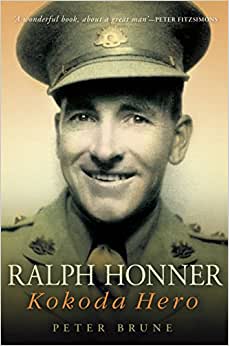Chaplain Matthew Stuart at Kapooka inspired my curiosity about Kokoda when he said Australia looks back to Gallipoli as the founding moment of our ANZAC heritage, rightly so, but we have just as much or more to learn from Kokoda. Kapooka chaplains use a video of the Battle of Isurava and LTCOL Ralph Honner’s address to the 39th Battalion to illustrate ADF values. My grandfather Sidney Humphreys also served in the Middle East and New Guinea. This all inspired me to turn to Peter Brune’s biography of Ralph Honner: Kokoda Hero.
The book details the family background, life (1904-1994) and military service (1936-1944) of Lieutenant Colonel Ralph Hyacinth (Jump) Honner DCO MC. We read of his great grandparents and grandparents emigrating from Ireland, Catholic schooling during WWI, training and work as a teacher, training as a lawyer, marriage to Marjory, operational service in the Middle East and PNG, rehabilitation from war wounds, staff role in Directorate of Military Training where he worked on creating training manuals, work as Chairman of a War Pensions Assessment Appeal Tribunal (1944-68), contribution to the Catholic Church and the Liberal Party including President of the NSW Branch (1961-63), Ambassadorship to Ireland (1968-1972) and retirement. He had also served in the Army Reserve which was then known as the Citizen Forces (1924-27) though this is curiously not mentioned.
Ralph joined the Western Desert campaign as a Captain in the 2/11th Battalion. Brune describes how he learned valuable lessons while fighting at Bardia, Tobruk and Derna (especially offensive infantry tactics and artillery coordination) then Greece (which was a fighting withdrawal, for which he was later awarded the Military Cross) and Crete (more a set piece defence). These tactics, as Brune explains, were important lessons for New Guinea.
The highlight of the book and Honner’s career was undoubtedly his leadership of the 39th Battalion in the fighting withdrawal on the Kokoda Trail especially the ‘defining moment’ of Battle of Isurava (26-31 Aug 1942), and later the ‘ultimate triumph’ at the Battle of Buna-Gona (16 Nov 42-22 Jan 43). Being awarded the Distinguished Service Order after Gona recognized his outstanding moral courage and creative intellect. I was fascinated to read of the influence of a commander’s leadership building morale, the utilization of a strategic fighting withdrawal against overwhelming numbers, and offensive movement with combined artillery support. I also enjoyed reading of Padre Norbert ‘Nobby’ Earl’s support of his commander and the battalion, including a rescue and care of a battle casualty (p.168). But there were also tragic action review lessons to consider from poor intelligence, lack of communication, pressure of quick results, futile attacks without reconnaissance, and apparent disloyalty and self-service from Higher Command, epitomised by General Blamey’s Koitaki diatribe where he criticized the Maroubra Force’s withdrawal as defeat. In contrast, Honner likened it to the bravery and sacrifice of Thermopylae delaying a superior-sized Army. Honner consistently seemed to be able to bring the best out of his troops, despite lack of training or battle weariness. He later commented: “It’s a confidence business; all war is a confidence business. If there isn’t confidence in your mates and your leadership, and your weapons and your training, you’re not good soldiers” (p.60).
Honner’s last command was of the 2/14th Battalion, until he was shot leading a recce advancing from Wampun on 4 Oct 1943. The respect of his own troops was also held by the opposing force, amazingly shown years later when amid the formality of his funeral, a Japanese veteran approached the coffin, stiffly bowed in respect, and bowed again and offered a letter of condolence to his family (p.2).
Honner’s biographer Peter Brune is a best-selling Australian military author who also authored Our Great Hearted Men about 100 day battles of Australian Corps in WWI and how they learned to incorporate coordinated firepower, Descent into Hell on Singapore, Changi and the Thai-Burma Railway, and A Bastard of a Place about the tactical battles and political manoeuvring of Papua battles. Brune offers outstanding historiography, drawing on interviews not just War Memorial documents and identifying failures of tactics and strategy as well as stories of chivalry and strategic brilliance.
Ralph Honner: Kokoda Hero is an especially timely book to read in 2022, the 80th anniversary of the battles of Isurava, Buna-Gona, and although not covered in the book the related Bombing of Darwin (19 Feb 1942). The copy of my book is now in the hands of my young adult children with the encouragement to digest the lessons of Kokoda’s story that are relevant for soldiers, commanders and non-military spheres.
Notes:
The views expressed in this article are those of the author and do not necessarily reflect the position of the Australian Army, the Department of Defence or the Australian Government.
About the Author: Darren Cronshaw is a Chaplain in the Part-Time Army serving in 2022 at Army School of Transport, Puckapunyal and previously at the 1st Recruit Training Battalion, Kapooka. For civilian work he pastors Auburn Baptist Church and teaches leadership and research methods with Australian College of Ministries (Sydney College of Divinity).

